improvement
Back in the 1950's ,after World War II concluded, US army recreation facilities
in Japan were first equipped with American made game machines. Within a short
time, Japanese department stores went along with this by placing Carousels and
kiddy rides on their top floors. In the 1960's, such "playgrounds" became commonplace
in amusement parks, movie, theaters, hotels and shopping centers. They primarily
featured shooting games, racing games and American-style table games. Japan's
first large-scale amusement center was opened by Taito in Osaka and took the
development of arcades to a whole new level.
Electronic games and arcades grew in popularity along with bowling and soon
led to the appearance of adult-oriented games and machines. In 1971, Sigma opened
the first arcade center in Tokyo in the shinjuku district. The gradual development
of video games in the 1970's, led to the "Intruder" game craze in 1978. Afterwards,
numerous games were released causing a game tea house and arcade center boom.
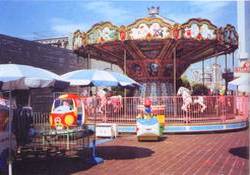 Children's
Children'srides on the top floors of department stores was the beginning for Japanese
arcades. (Pictured is a scene of an outdoor play area on the
top floor of Shi-wu department stores, Ikebukuro, Japan)
In 1985 the "Justifying Operation Law" was passed that prohibited excessive
arcade development. This marked the end of the "golden age" of arcades and the
decline of the small arcade. However, with proprietors' efforts, arcade center
gradually overcame their negative reputation and began to redecorate, opening
larger centers that were bright and clean. In the early 1990's, large-scale
game centers appeared one after another with downtown styles, suburban styles
and huge amusement park-like facilities. These centers successfully attracted
huge numbers of visitors and made the development of large arcades an important
trend. At the same time, small theme parks were also on the rise. In the late
1990's, in reaction to home video games and a stagnating market, new game and
machines were introduced one after another, particularly large simulation games.
These new games were much different from home video games and brought about
a resurgence in the development of arcades.
Today: Tough times and new challenges
Top 5 Machines in Japan's Arcades January-June 2000
Rank
Video Game Machine
Cockpit/Upright Machine
Prize Machine
1
Virtua Strike 2 Version 2 Version 2000 (Sega)
DDR 3rd Mix (Konami)
New UFO Catcher (Sega)
2
Tekken Tag Tournament (Namco)
Percussion Freaks (Konami)
Fancy Liter (Kato's)
3
Mr Driller (Namco)
Samba de Amigo (Sega)
UFO Prize Machine (Sega)
4
Virtua Tennis (Sega)
The House of the Dead 2 (Sega)
UFO Prize Machine (Sega)
5
Garou Mark of The Wolves (SNK)
Time Crisis 2 (Namco)
UFO Catcher 21 (Sega)
Today, dark times have descended upon Japan's amusement
industry. First there was the Asian financial crises. Japan was particularly
hard hit during this time. Then there was the worldwide recession of the amusement
industry in general. As a result of the overall market depression, Sega replaced
its chairman several times, SNK, Sigma and Jaleco merged, and the income of
almost every amusement company fell with some even having to shut down. According
to the AOU's investigative report on the state of Japan's amusement industry,
the total amount of arcade centers around the whole of Japan in 1999 was 38,672,
down 10.4% from 43,174 in 1998. Arcades of all sizes are in decline. Small arcades
with less than 50 machines are still in the majority (34,506 locations in 1998,
32,519 in 1999) but the number is declining. Over the past few years, medium
sized arcade centers have been increasing, but the number dropped over the last
year. In 1998, there were still 4,682 medium sized arcades, but that number
fell to 2,943 in 1999. The number of large-sized arcade centers went down from
3,986 in 1998 to 3,209 in 1999. The total income of arcade centers has also
greatly declined over the last two years.
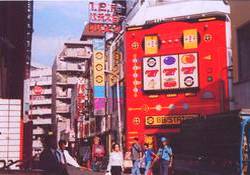 The
Thelarger arcades in Japan usually have five game zones: video game machines, music
and dance machines, prize machines, coin-op game machines and AM vending machines.
Generally speaking, AWP machines had the best performance of all machines last
year. In 1999, there were 233,000 prize machines in Japan with a total income
of 237.3 billion yen (US$2.23 billion dollars). Although there has been slight
growth since last year, the growth rate has fallen dramatically. Due to constraints
on prize amounts, operators are worried that AWP machines will not see any improvement
over the next six months. Video game machine still have the most machine to
become the top earner among amusement machines. As for coin-op game machines,
the introduction of refurbished coin-op machines such as pachinko and slot machines
has made the total number of increase, but their income has fallen. Also, the
income and the amount of AM vending machines have both decreased, but the downward
growth rate has been gradually slowing down. This may be due to new machines
that make use of the Internet and cell phones. Recently, the most popular machines
in Japan included Virtua Striker from Sega, Dance Dance Revolution from Konami,
and UFO catcher from Sega.
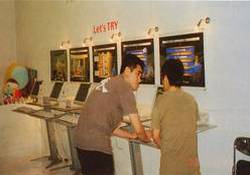
According to the AOU report, out of a sample of 15,685
arcade visitors, 53.2% were male and 46.8% were female. Five years ago,
males made up 71.4% and females the remaining 28.6%. This
indicates that females are much more attracted to arcades than before and is
probably responsible for the rise in such female-oriented machines as AWP and
photo sticker machines. The report also asked arcade visitors why they visited
arcades. More than 50% said to play the games and win prizes while 40% said
it was to kill time or meet friends. Two-thirds of visitors visit arcades one
to five time per month, more than 80% people stay least two hours each visit,
and the average consumption range is 500 to 1000 yen.
Tomorrow: Talking action and focusing on customer
service
Although the amusement industry has been through its
ups and downs in the past, it has never been as serious as in the last two years.
If no changes are made in the administrative policies, operation changes and
rising taxes may cause the entire industry to face a struggle for its very existence
within three years.
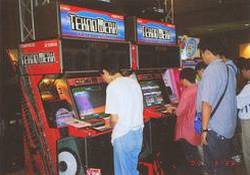
Music and dance machines have been a big hit in Asia, but have begun to cool
down. (On the picture, it is the Tekno Week exhibited by Namco in JAMMA show
2000) In response to the current recession, some proprietors
have temporarily shut down their arcades awaiting future opportunities. Some
have extended their opening hours and others have left the industry completely.
Generally speaking, operators have a constant sense of instability and crisis.
They are faced with the problem of the best way to rebuild.
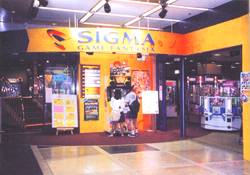
According to a survey the number and revenues of all
sizes of arcades are a zero or negative growth. In order to help rejuvenate
the arcade industry, the Japan Arcade Center Association was founded on Feb
16th, 1999. Yu Sen-Shiun, the chairman and the president of Hanyu Co., stated
that hereafter the only way to service was for the whole industry to work together.
All association members can use the arcade center Internet system to share information.
For example, players may look at their ranking in all of Japan. The association
further uses 10 arcades to collect information on the most popular prizes and
games each week and then publishes the information on the Internet. Tien Ching-Fu,
Vice chairman of the association and the president of New Star Co., added that
an online competition may be offered for arcade center visitors with the cooperation
of electronic game producers in the future. Another service is that each arcade
may directly download game software to update game through the association's
Internet service system. This makes changing game boards unnecessary.
Some owners, however, don't believe it's possible for arcades to cooperate
and grow together. During such hard times, everyone must fend for themselves.
They favor providing both Internet games and traditional games together like
in the US. Arcade owners can no longer depend on manufacturers to regularly
produce new, innovative games. They must take action themselves to change laws
and attract customers.
Annual Business Statistics for Japan's Arcades (1995-1999)
Year
1995
1996
1997
1998
1999
Business Volume of Each
Machine in 1999 (Yen/Each)
Video Game
Business Volume.
(100 Million Yens)
2303
1990
1880
1529
1321
441,806.0
Quantity of Machines (Ten Thousand)
42.5
39.5
39.0
34.8
29.9
Music Machine
Business Volume.
(100 Million Yens)
N/A
N/A
Start in 1997
24.7
334
1,323,076.9
Quantity of Machines (Ten Thousand)
N/A
N/A
Start in 1997
1.3
2.6
Gift Machine
Business Volume.
(100 Million Yens)
1710
1948
1917
2309
2373
1,018,454.9
Quantity of Machines (Ten Thousand)
19.2
19.5
19.5
20.7
23.3
Token Machine
Business Volume.
(100 Million Yens)
1309
1146
1148
1235
1176
642,622.9
Quantity of Machines (Ten Thousand)
11.8
13.6
14.6
16.6
18.3
AM Vending Machine
Business Volume.
(100 Million Yens)
Start in 1995
604
1013
418
395
987,500
Quantity of Machines (Ten Thousand)
Start in 1995
3.5
5.0
4.7
4.0
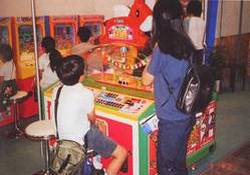
Facing declining consumption and a lack of innovative new games, arcade operators
are examining the future of the electronic game industry. Business hours limited
by the Justifying Operating Law. Arcades must become more customer service oriented
and listen to the demands of players. Almost 50% of customers in arcades go
for reasons other than merely playing games and winning prizes. Arcades must
have an environment that will attract these kinds of people as well as players.
Playing costs is another important issue. The average amusement machine in Japan
costs 200 yen per play. Now, some owners are lowering that amount to 100 yen
after 6:00 in the evening. Some even offer a few free machines to attract players.
Many owners hope the concept of 100 yen games will become more widespread.
Whether the Japanese electronic game industry will turn the present crisis
into success and retake their previous industry leading position depends a great
deal on arcades. They are the front lines in this industry. Manufacturers also
play an important role in inventing original consumer-oriented machines to reclaim
lost customers and attract new ones. So far, the 21st century has presented
quite a challenge. It remains to be seen if this period will be seen as the
end of a legacy or a mere growing pain on the road to even grater heights for
the Japanese amusement industry.
This article appeared in the No.24 (November 2000) issue
of the Game Time International Magazine which also featured an interview with
JAMMA president, Yoshihito Kakihara along with an in depth look at the JAMMA
SHOW, a company profile on Feiloli Electronic Co.,Ltd. and much more.
Haw Tian Co.,LTD.
2f, No 17, Pao Ching St., Taipei 105
Tel:
+886-2-2760-7407
Fax:
+886-2-2762-3873
E-mail:
gametime@seed.net.tw
twslot@ms33.hinet.net
Website:
http://www.taiwanslot.com.tw




